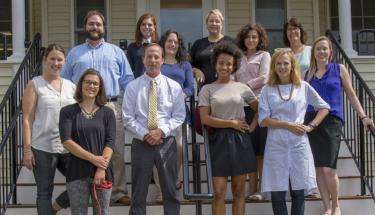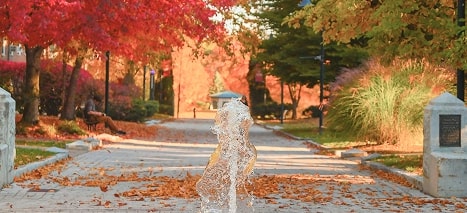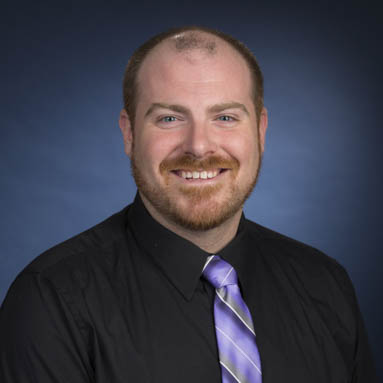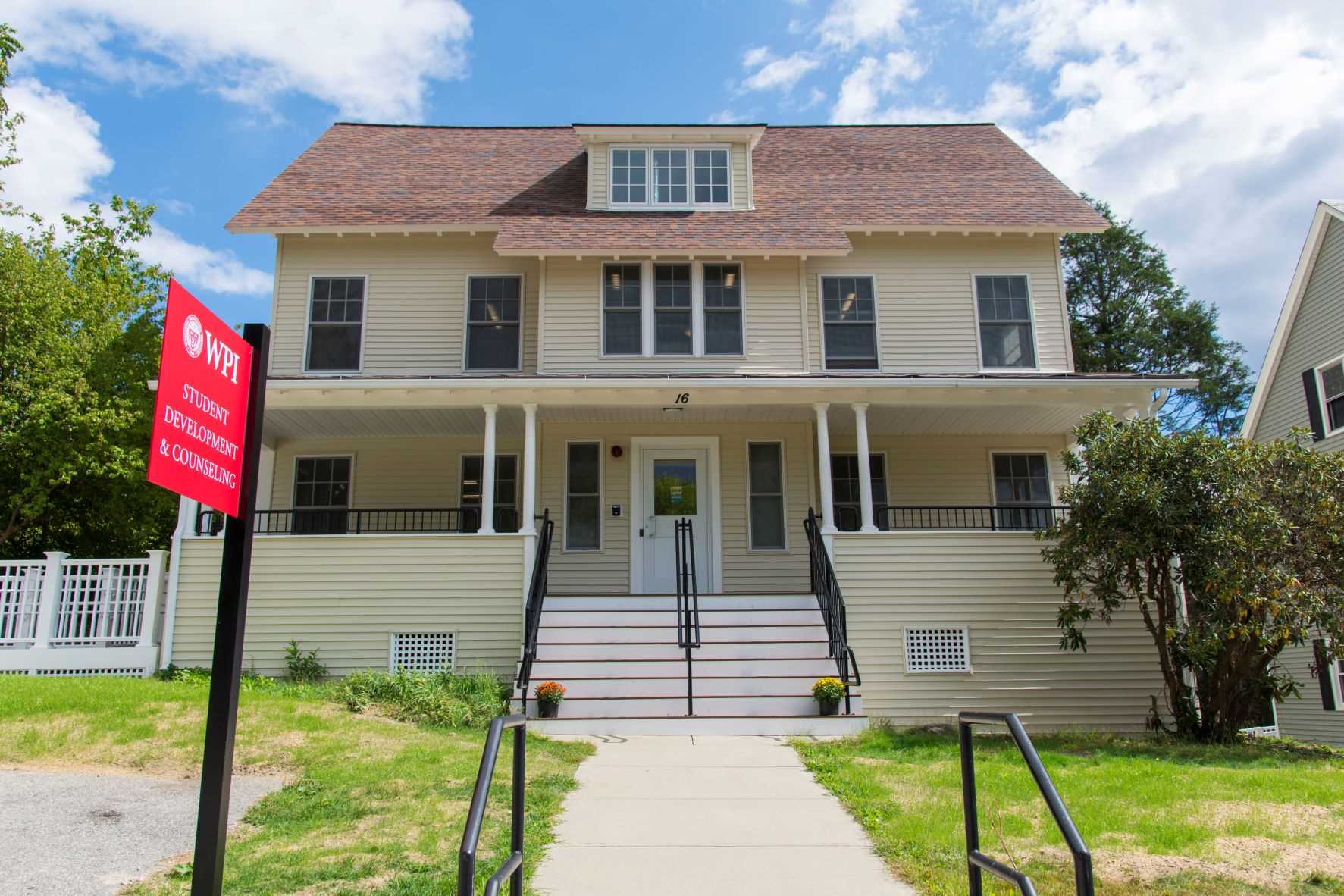On the outside, college life looks ideal. Examining topics you’re passionate about, exploring new ideas, meeting new people, being on your own (but with some backup), and hanging out with your friends in your spare time. What’s not to enjoy?
Unfortunately, today’s college students experience a much different reality. Faced with a relentless pressure (sometimes from society, sometimes from parents, sometimes from themselves) to succeed at all costs while trying to juggle life on their own amid an onslaught of information and social media, today’s students are among the most stressed out universities have ever seen.
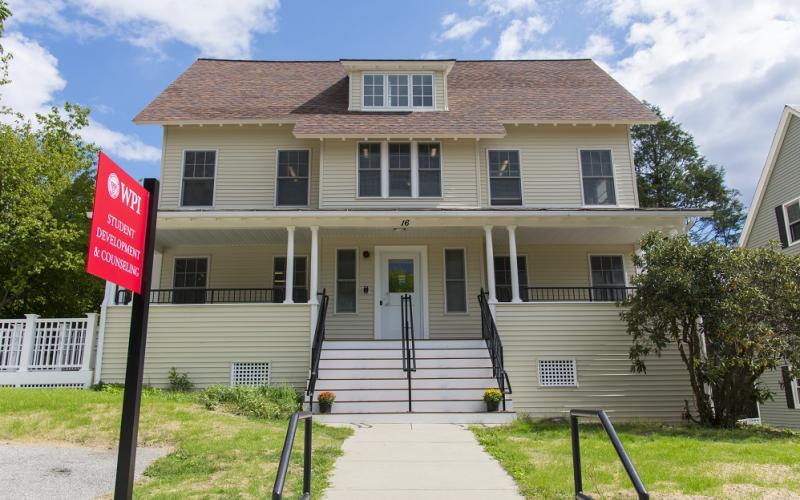
The SDCC's new home at 16 Einhorn Road.
Charles Morse, associate dean for student development and director of counseling at WPI’s Student Development and Counseling Center (SDCC), says the need for high-quality mental health services is increasing on campuses nationwide and WPI is no exception. A decade ago, the SDCC saw 7 to 8 percent of the undergraduate population throughout the year. Today, approximately 15 percent of undergrads seek their support and services. WPI’s rates are slightly lower than the national average for similar colleges, but Morse says that’s likely the result of having a higher proportion of male students, who are statistically less likely to seek help.
The SDCC recently moved from West Street to 16 Einhorn to make room for the essential services that help students have a better college experience and to continue building the strong foundations necessary for students to thrive.
“There’s tremendous support of mental health services at WPI,” says Morse. “From the top down, it is valued here, and that enriches our work.” When the administration heard the space crunch was having an impact on how the SDCC could offer services, they set about finding a solution that would work.
Although Morse says there’s never been a waitlist to be seen at the SDCC, the additional space is more practical and it opens up possibilities. The move expands the available clinical spaces from 8 to 14, which are used constantly. There’s no more disruption from shuffling in and out of offices so clinical meetings can take place. And the buildings (SDCC is also using renovated space in 12 Einhorn) give a flow to the services that was previously missing. Everyone checks into the 16 Einhorn office where a student might meet with a counselor. In 12 Einhorn, there’s space to advance some of the student-led programs like peer support groups, student development programs, and even the popular drop-in meditation sessions. The move has even allowed the addition of another graduate student psychology intern to bring the total to three.
And while the stigma surrounding mental health issues is beginning to lessen throughout society, some students still feel it and delay getting help. They may not realize help is needed until they are in crisis. “Students come here when they need to,” says Morse. “Most are at risk.” That means they are dropping off in functionality, he says, so maybe they are unable to get to class, to complete work, or sometimes to even get out of bed. Others might be prone to anger, violence, or aggression—like having thoughts of harming themselves or others, or experiencing harmful behaviors around alcohol, drugs, or interpersonal relationships. There’s so much complexity around the emotional distress students are feeling, that they don’t always recognize the warning signs in themselves.
“There’s tremendous support of mental health services at WPI. From the top down, it is valued here, and that enriches our work.” -Charles Morse
Morse says in the 25 years he’s been with the SDCC, anxiety has overtaken depression in the most common student diagnosis, but about half of the students who come to the SDCC have no diagnosis. They just have normal developmental struggles that could be around relationships, family issues, or dealing with student life. Clearly, Morse says, technology plays a role in the rise of anxiety in students. Students today are exposed to much more content that doesn’t always mesh with their cognitive or developmental ability to process it. They communicate through technology with a greater number of people than in previous generations. But the communication is less personal—most of the time there’s no face-to-face contact or even any voice communication. The result is a greater sense of loneliness, a sense of less connection with friends, and a feeling of less belonging in the WPI community.
The strain is relentless. “Students are feeling many points of pressure to succeed, to be involved in a number of clubs/activities to be reflected on their resume, to experience new and exciting opportunities on-campus and in the community, to sustain and do well with the academic rigor, and to thrive in an ever-changing society,” says Matthew Foster, assistant director of residential education for the Housing & Residential Experience Center.
The SDCC helps students in many ways through its counseling services and programs, available resources, and tips on the SDCC Facebook page. Students can request one-on-one counseling with one of the six full-time or three part-time counselors, and they can also join groups that address women’s and LGBTQIA+ issues or they can participate in a group to learn core coping skills. Students may choose to access Therapy Assisted Online (TAO) software to help them practice skills online as a supplement to therapy. Eventually, Morse would like to see the entire student body using TAO.
SDCC staff are out on campus and in the community running seminars and training students, faculty, and staff to help students in distress. Morse says resident advisors invite SDCC staff to give talks on time management tips or stress management skills. Or they might work with a fraternity or a sorority on managing interpersonal dynamics or on leadership dynamics. They also work closely with faculty to help them manage situations with students in distress.
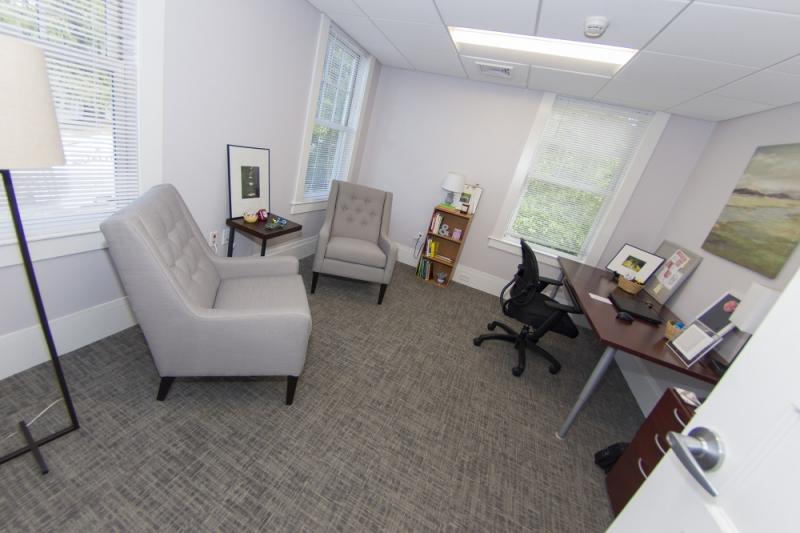
The SDCC's new location offers a more practical space
that opens up more possibilities for student care.
According to Foster, the in-person talks help students and staff gain familiarity with the assistance the SDCC offers. the Housing & Residential Experience Center staff look to the SDCC for guidance on how to best support student workers and residents, and they also learn the best ways to begin a difficult conversation. “The seminars, discussions, and talks that the SDCC brings to the halls and students themselves is so important because the students can put a name to a face and hear that their concerns and discomfort is real and does live here on campus and in the halls,” says Foster. “It allows for the students to get beneficial information about services offered, information about ways to handle stress or other types of concerns, and information on the SDCC’s location, staff, and environment.”
The evidence-based and popular Student Support Network is a six-week intensive training workshop offered to faculty and staff during A-Term and then to several cohorts of 15 to 18 students in other terms for the remainder of the academic year. The course offers practical approaches to helping students, distinguishing red flag behavior, and deciding what approaches will help the situation. Students aren’t always going to go to the SDCC on their own—some might not even realize they need help. However, having others on campus who can spot concerning behavior, like a student who slowly withdraws from friends or even one whose anxiety propels them to fill every second of the day with activity, can help students get crucial help and support.
Each year, the SDCC trains approximately 100 students through the Student Support Network and there is always a waiting list. Those numbers are encouraging to Morse, but they also tell a bigger story. The numbers reveal just how many students recognize that helping others and supporting safety is a responsibility of being part of a community like WPI.
If students think SDCC services might help them, they can call 508-831-5540 to ask questions or schedule an appointment. Morse says he tells students a good indicator that support will help is when your emotional well-being is getting in the way of the person you want to be. Whether that means you avoid new social situations or you can’t get out of bed, if your actions aren’t meeting your expectations for yourself, the SDCC can help.
If Morse can make anything crystal clear to students, it is this: You are not alone in how you feel. “Being a human being, you’re aware of all the stuff on the inside and that’s messy,” he says. “That’s the normal human condition.” Look around when you feel like that and know that most of the other people you’re looking at, no matter how pulled together they seem, are experiencing struggles of their own.
Recognizing that you need to take the time to care for yourself and how best to do that is a great lesson for being a successful student. “Go to class and be a student here,” says Morse. “Try to engage socially and find your people, even if that might require joining a few clubs. Spend an hour on yourself each day whether that’s reflecting, writing, drawing, exercising. Make sure to take breaks from your phone and homework.”
To learn more, call the SDCC at 508-831-5540, send them an email at sdcc@wpi.edu, or stop by during walk-in hours Monday through Friday from 2 to 3 pm.
- By Julia Quinn-Szcesuil
